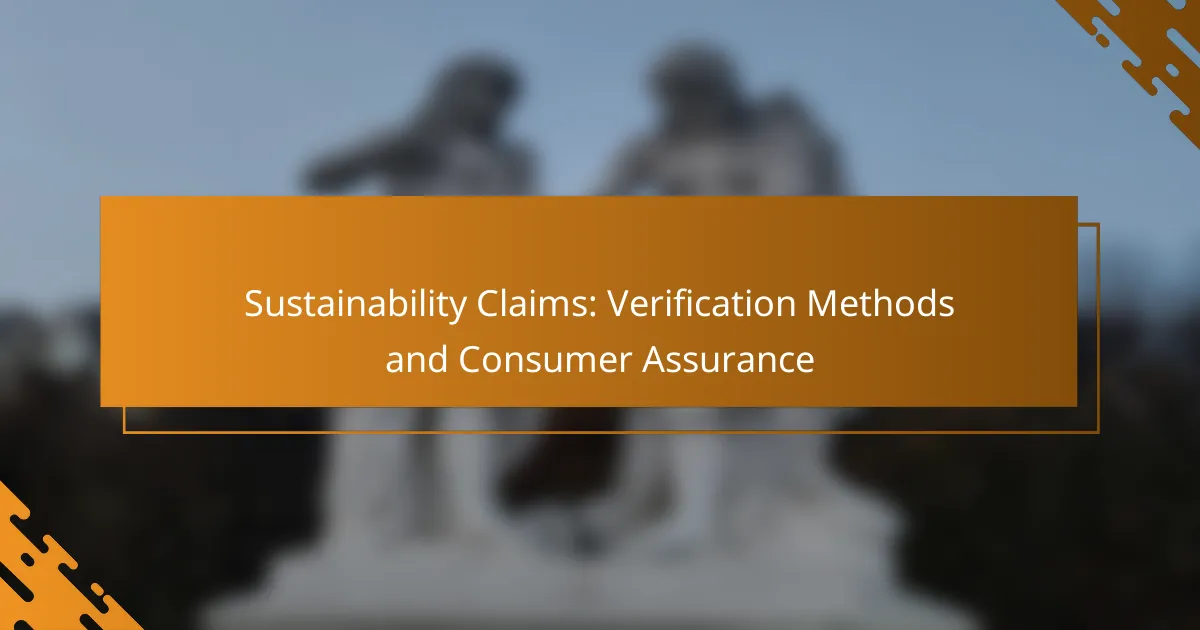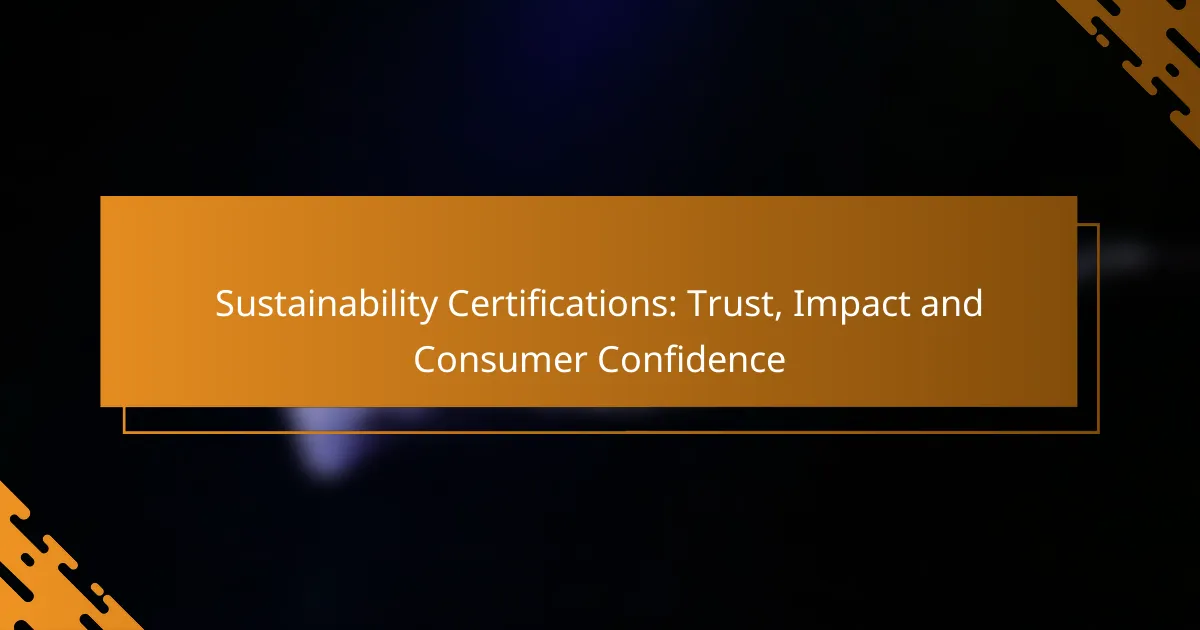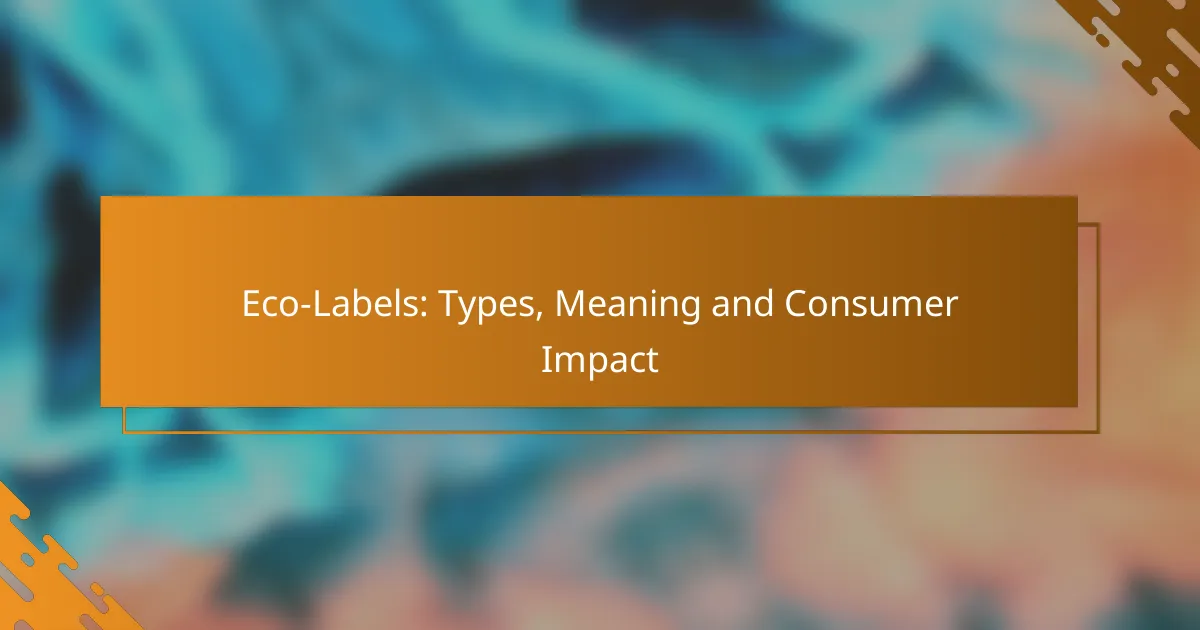In the realm of e-commerce, verifying sustainability claims is crucial for ensuring transparency and accountability. Various methods, such as third-party certifications and life cycle assessments, provide consumers with the assurance that products adhere to specific environmental and social standards. This verification not only enhances credibility and fosters trust but also contributes to a company’s competitive edge in the market.
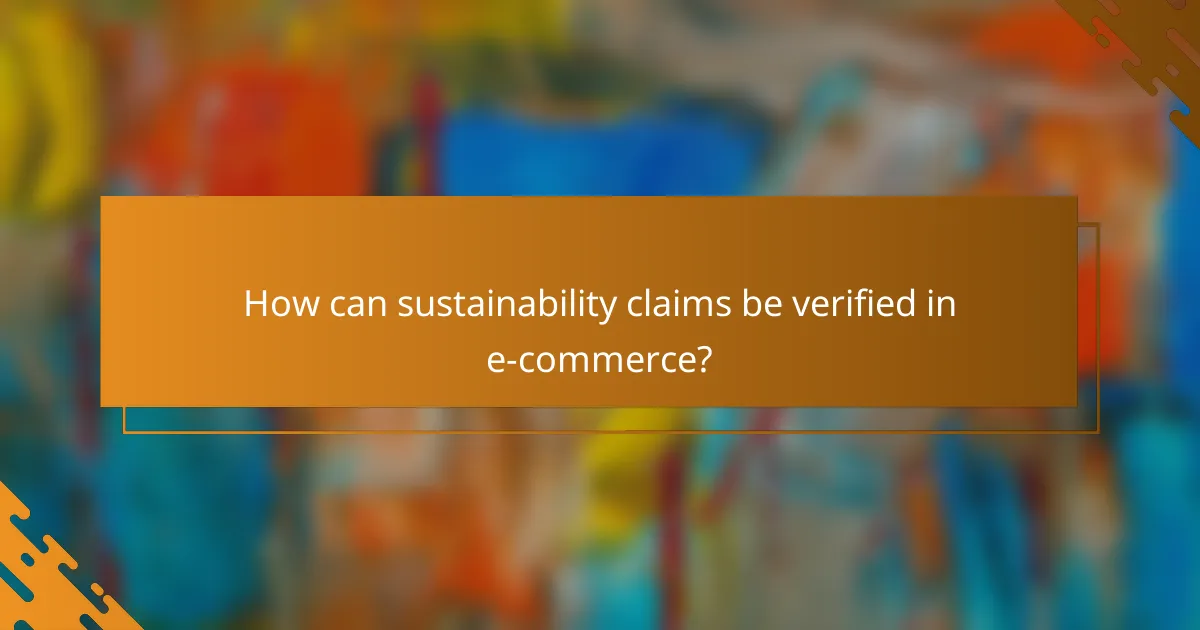
How can sustainability claims be verified in e-commerce?
Sustainability claims in e-commerce can be verified through various methods that ensure transparency and accountability. These methods include third-party certifications, life cycle assessments, consumer feedback analysis, blockchain technology, and supply chain audits.
Third-party certification
Third-party certification involves independent organizations evaluating and verifying a company’s sustainability practices against established standards. Certifications such as Fair Trade, USDA Organic, and Energy Star provide consumers with assurance that products meet specific environmental and ethical criteria.
When choosing products, look for these certifications as they can indicate a higher level of commitment to sustainability. However, be aware that not all certifications are created equal; some may have stricter requirements than others.
Life cycle assessment
Life cycle assessment (LCA) evaluates the environmental impact of a product from its inception to disposal. This method considers factors such as resource extraction, manufacturing, distribution, use, and end-of-life disposal.
Companies can use LCA to identify areas for improvement and reduce their overall environmental footprint. Consumers can look for products that provide LCA data, which can help in making informed purchasing decisions.
Consumer feedback analysis
Consumer feedback analysis involves collecting and evaluating customer opinions regarding a product’s sustainability claims. This can be done through surveys, reviews, and social media monitoring.
Brands can leverage this feedback to enhance their sustainability practices and address any discrepancies between claims and consumer perceptions. Shoppers should consider reviews that specifically mention sustainability to gauge a product’s true impact.
Blockchain technology
Blockchain technology offers a transparent and secure way to track a product’s journey through the supply chain. By recording every transaction on a decentralized ledger, consumers can verify the authenticity of sustainability claims.
Some brands are already using blockchain to provide real-time data about sourcing and production practices. When available, look for blockchain-backed products to ensure greater transparency in sustainability claims.
Supply chain audits
Supply chain audits assess the practices of suppliers and manufacturers to ensure compliance with sustainability standards. These audits can reveal whether companies are adhering to ethical sourcing and environmental regulations.
Regular audits can help businesses identify risks and improve their sustainability efforts. Consumers should inquire about a brand’s audit practices, as transparency in the supply chain is crucial for verifying sustainability claims.

What are the benefits of verified sustainability claims?
Verified sustainability claims provide assurance to consumers that products meet specific environmental and social standards. This verification enhances credibility, fosters trust, and can lead to increased market competitiveness.
Increased consumer trust
When sustainability claims are verified, consumers are more likely to trust the information provided by brands. Verified claims reduce skepticism and misinformation, allowing consumers to make informed choices aligned with their values.
For example, a product certified by a recognized third-party organization can significantly boost consumer confidence compared to unverified claims. This trust can lead to customer loyalty and repeat purchases.
Enhanced brand reputation
Brands that commit to verified sustainability claims often enjoy a stronger reputation in the marketplace. This positive perception can differentiate them from competitors who may not prioritize transparency or sustainability.
Engaging in verified practices can also attract media attention and positive reviews, further solidifying a brand’s image as a responsible and ethical choice. Companies that showcase their verified sustainability efforts can appeal to environmentally conscious consumers.
Improved sales performance
Verified sustainability claims can lead to improved sales performance as consumers increasingly prefer products that align with their ethical beliefs. Brands that effectively communicate their verified claims may see a boost in market share.
Research indicates that consumers are willing to pay a premium for sustainably sourced products, often in the range of 10-20% more. This willingness can translate into higher profit margins for brands that prioritize sustainability.
Regulatory compliance
Many countries are implementing stricter regulations regarding sustainability claims, making verification essential for compliance. Verified claims help brands avoid legal issues and potential penalties associated with misleading advertising.
Staying ahead of regulatory requirements not only protects a brand but also positions it as a leader in sustainability. Companies should regularly review local regulations to ensure their claims remain compliant and credible.
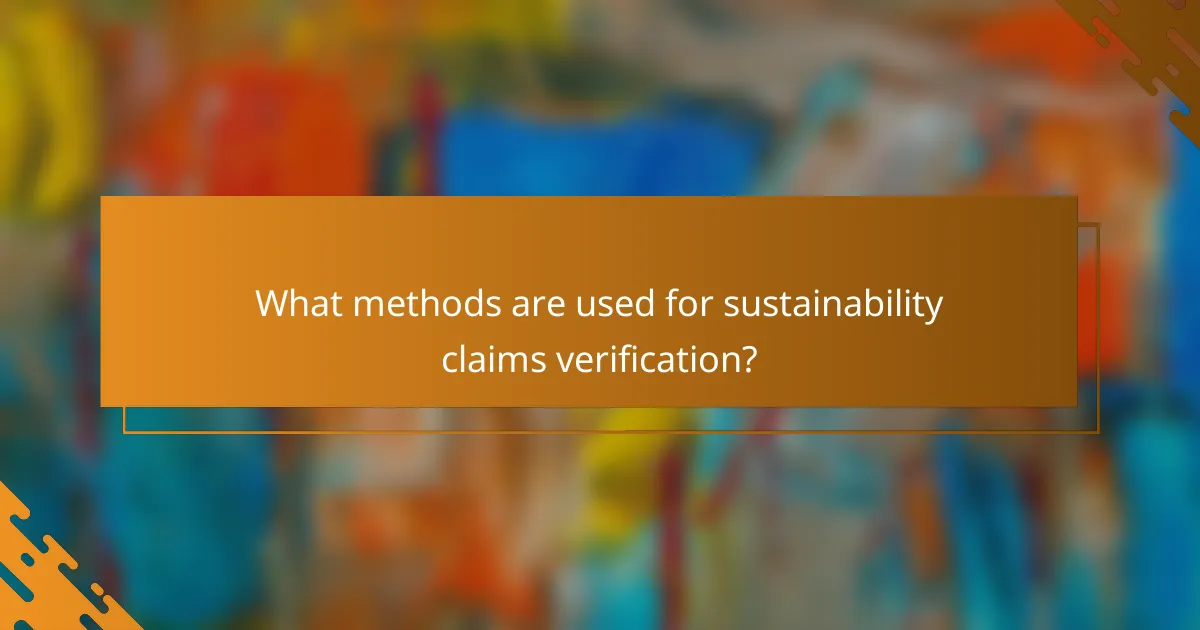
What methods are used for sustainability claims verification?
Sustainability claims verification employs various methods to ensure that companies’ environmental assertions are credible and accurate. Key methods include ISO standards, Environmental Product Declarations, carbon footprint calculations, and transparency reports, each serving a specific purpose in validating sustainability efforts.
ISO standards
ISO standards provide a framework for organizations to demonstrate their commitment to sustainability through established criteria. For example, ISO 14001 focuses on effective environmental management systems, helping companies minimize their environmental impact while enhancing operational efficiency.
When evaluating sustainability claims, look for certifications that indicate adherence to ISO standards. This can include third-party audits, which ensure that practices align with international benchmarks, thus providing assurance to consumers.
Environmental Product Declarations
Environmental Product Declarations (EPDs) offer a standardized way to communicate the environmental impact of products throughout their lifecycle. EPDs are based on life cycle assessments (LCAs) and provide detailed information on resource use, emissions, and waste generation.
Consumers can use EPDs to compare products based on their environmental performance. When assessing EPDs, check for third-party verification to ensure the information is reliable and not self-reported, which can sometimes lead to misleading claims.
Carbon footprint calculations
Carbon footprint calculations quantify the total greenhouse gas emissions associated with a product or service, helping consumers understand its environmental impact. These calculations typically consider emissions from production, transportation, usage, and disposal phases.
To evaluate sustainability claims effectively, look for companies that provide clear carbon footprint data, ideally verified by an independent third party. This transparency can help you make informed choices about the environmental implications of your purchases.
Transparency reports
Transparency reports are comprehensive documents that disclose a company’s sustainability practices, goals, and progress. These reports often include data on emissions, resource consumption, and social responsibility initiatives, providing a holistic view of a company’s environmental impact.
When reviewing transparency reports, consider the frequency of updates and the depth of information provided. Reports that are regularly published and include specific metrics tend to offer greater assurance of a company’s commitment to sustainability and accountability.
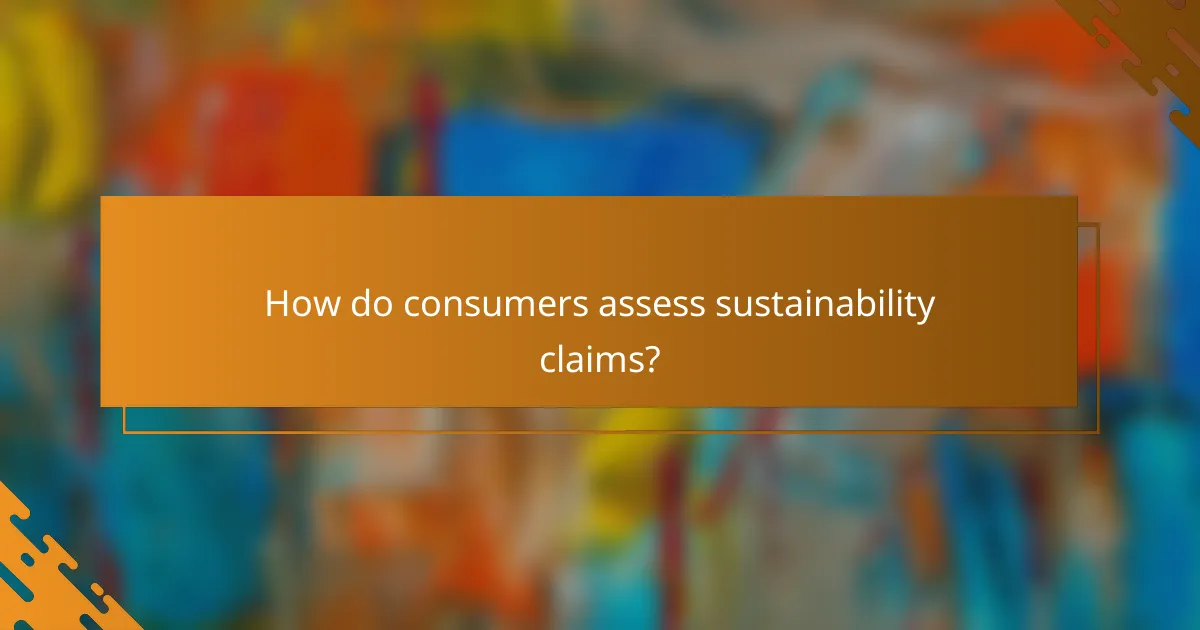
How do consumers assess sustainability claims?
Consumers assess sustainability claims through various methods, focusing on credibility and transparency. They often rely on recognizable labels, brand research, and peer feedback to determine the authenticity of these claims.
Label recognition
Label recognition plays a crucial role in how consumers evaluate sustainability claims. Familiar certifications, such as Fair Trade or Energy Star, provide a quick reference for consumers looking for environmentally friendly products. These labels often indicate adherence to established standards, making it easier for shoppers to make informed choices.
When assessing labels, consumers should look for transparency in the certification process. Understanding what criteria a label represents can help differentiate between genuine sustainability efforts and misleading marketing tactics.
Research on brands
Many consumers conduct research on brands to verify their sustainability claims. This can include checking the company’s website for sustainability reports, third-party audits, or participation in recognized environmental initiatives. A brand’s history and reputation in sustainability can significantly influence consumer trust.
Online reviews and articles can provide insights into a brand’s practices. Consumers should consider looking for independent sources that evaluate a brand’s sustainability efforts rather than solely relying on the brand’s own marketing materials.
Peer reviews and testimonials
Peer reviews and testimonials are valuable for assessing sustainability claims, as they offer real-life experiences from other consumers. Platforms like social media or product review sites can provide insights into how well a product lives up to its sustainability promises.
When reading testimonials, consumers should look for detailed feedback rather than vague statements. Reviews that discuss specific aspects of a product’s sustainability, such as materials used or production methods, can provide a clearer picture of its environmental impact.
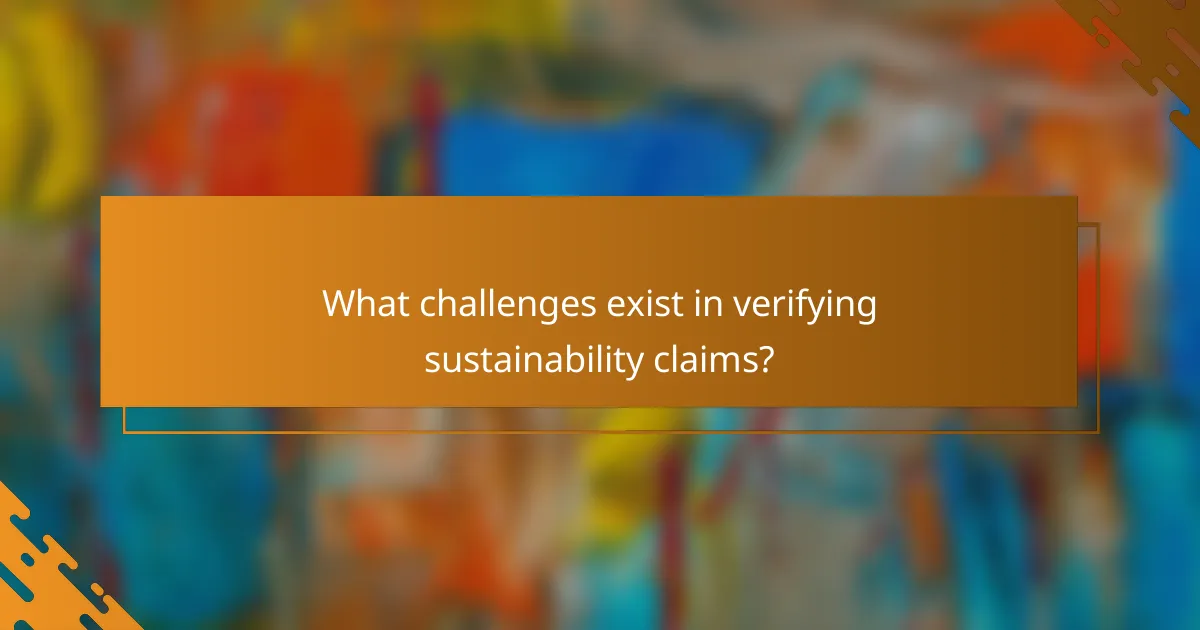
What challenges exist in verifying sustainability claims?
Verifying sustainability claims presents several challenges, primarily due to the complexity of environmental impacts and the lack of uniform standards. These obstacles can lead to confusion among consumers and undermine trust in sustainability initiatives.
Lack of standardized metrics
The absence of standardized metrics makes it difficult to assess sustainability claims consistently. Different organizations may use varying criteria, leading to discrepancies in how sustainability is measured and reported. For instance, one company might focus on carbon emissions, while another emphasizes water usage, complicating direct comparisons.
Consumers often struggle to understand these metrics, which can vary widely across industries. To navigate this, look for certifications from recognized bodies, such as the Global Reporting Initiative (GRI) or ISO 14001, which can provide more reliable benchmarks for sustainability.
Greenwashing concerns
Greenwashing occurs when companies exaggerate or falsify their environmental efforts to appear more sustainable than they are. This practice can mislead consumers and dilute the credibility of genuine sustainability initiatives. For example, a product labeled as “eco-friendly” may contain only a small percentage of sustainable materials, while the rest are conventional.
To avoid falling for greenwashing, consumers should research brands and seek transparency in their sustainability practices. Checking for third-party certifications and reading product labels carefully can help identify truly sustainable options. Additionally, being aware of common greenwashing tactics, such as vague language or misleading imagery, is crucial for making informed choices.
